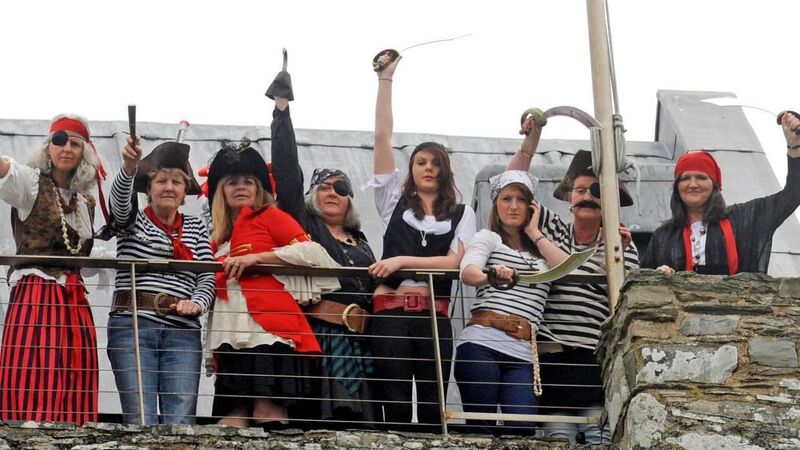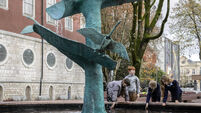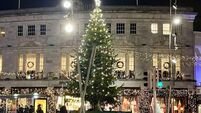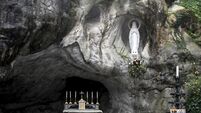There be pirates, in Cork! Recalling the raid that enslaved 105 villagers

It lies about 60 miles west of Cork city in the region known as West Cork, one of the most beautiful parts of Ireland, and the final stop on the 2,500 km (1,500 mile) Wild Atlantic Way.
The climate is mild thanks to the nearby Atlantic and the influence of the Gulf Stream.
Baltimore’s large natural harbour is formed partly by islands of the archipelago known as Carbery’s Hundred Isles, and around the pier, charter boats and pleasure craft jostle with fishing vessels and ferries serving the main islands.
The oldest part of the village, with its castle and rows of fishermen’s cottages, is spread along the eastern shore of the harbour. At its heart is the village ‘Square’ around which are clustered bars and restaurants looking west over sea and islands towards the ‘Land’s End’ of Ireland, Mizen Head.
Sounds idyllic. A nice place to visit, or maybe even a place to spend some time for a holiday with the family… or would it?
Would you be safe sitting outside the local pub with your pint, admiring the view of the harbour, or could your kids be hauled off by some marauding pirates to a foreign land, never to be seen again?
“That’s impossible,” you say, but can you be certain? After all, it happened before.
Granted, it was some time ago, 1631 in fact, when much of the local population was carried off by pirates, during an event known as the Sack of Baltimore.
Barbary pirates from north Africa, led by a Dutch captain-turned pirate, known as Murad Reis the Younger, raided Baltimore. The attack was quick and unexpected with the inhabitants taken completely by surprise.
More than 200 armed pirates landed in the Cove, torching the thatched roofs of the houses, and carried off with them “young and old out of their beds”.
It started on June 19, 1631, when the raiders gathered off the Old Head of Kinsale. They had already captured two fishing-boats from Dungarvan, one captained by John Hackett, the other by Thomas Carew, both containing five-man crews. The two 12-ton boats, now manned by pirates, joined the little flotilla, which continued westward.
Aboard the lead vessel, Captain Morat Rais, a Dutchman with extensive experience in the North Sea, demanded that Hackett pilot them into Kinsale. Perhaps aware of the presence of the Fifth Lion’s Whelp, under the command of Captain Hooke of the Royal Navy, in the harbour, Hackett allegedly persuaded Rais to continue on to Baltimore.
About 10pm on June 19, the ships anchored east of the mouth of Baltimore harbour. At 2am on the 20th, some 230 men, armed with muskets, landed at the Cove. Quickly and silently spreading out, they divided up and waited at the doors of the 26 cottages along the shoreline.
At a given signal, brandishing iron bars to break the doors and firebrands to torch the buildings, they launched a simultaneous attack on the sleeping inhabitants.
The marauders entered 40 houses, rifled 37 of them, and captured more victims.
William Harris was disturbed by the noise and quickly established what was happening. He grabbed his musket and ran to a wooded area from where he fired shots into the air to alert the remainder of the villagers. Another of the inhabitants grabbed his drum, ran to join Harris, and began beating the drum.
Rais realised that the element of surprise had been lost and he thought soldiers were on the way to challenge them. The pirates retreated quickly to the Cove and returned to their anchored ships. They had captured 20 men, 33 women and 54 children and youths, to add to the crews of the Dartmouth ship and the Dungarvan fishing-boats.
Some were destined to live out their days as galley slaves, which was often a brutal and short life. They would be starved and beaten by slave drivers and forced to work half naked as they powered the ship to their own doom.
They were sometimes worked until they dropped dead, at which point their bodies were dumped into the sea. Their destination was a huge slave market in Algiers, where white European slaves were highly sought after.
Most women were put to work as domestic slaves while others became concubines of the Ottoman Sultan in Constantinople. Many of the younger women would spend long years in the seclusion of the Sultan’s harem or within the walls of the Sultan’s palace as labourers.
In his book, Ekin explained that some of the female slaves converted to Islam and got married. They could have had a relatively pleasant life, living with their husbands and families in Algiers, which was a civilised city for the era.
A decade and a half after the slaves had been captured, the British government paid their ransom and planned to bring them home.
An envoy was sent to Algiers to repay the slave owners the money they spent at the slave market. However, only two out of the 105 slaves wanted to return home. The rest were happy to stay.







 App?
App?







